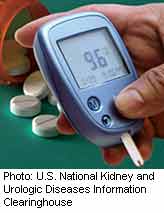
TUESDAY, March 8 (HealthDay News) — People living in certain areas of the United States are more likely to develop diabetes, according to a new government analysis.
Researchers from the U.S. Centers for Disease Control and Prevention have discovered that a wide swath across mostly southern U.S. states has diabetes rates above 11 percent, compared to 8.5 percent for the rest of the country.
“There’s a region of the U.S. that we identified as the ‘diabetes belt,'” said study author Lawrence Barker, associate director for science in the division of diabetes translation at the CDC in Atlanta. “People living inside the belt are more likely to have diabetes than those who live outside the belt,” he explained.
The CDC currently estimates that diabetes affects almost 26 million American adults, or just over 8 percent. There are two types of diabetes: type 1, which used to be known as juvenile diabetes; and type 2, formerly known as adult-onset diabetes.
Type 2 accounts for the majority of diabetes — possibly as much as 95 percent of all cases, according to Barker — and the risk of developing type 2 diabetes is influenced by genetics, weight and physical activity. Type 1 is believed to be an autoimmune disease. Weight and physical activity levels don’t contribute to the development of type 1 diabetes, he noted.
Barker and his colleagues reviewed data from the U.S. Behavioral Risk Factor Surveillance System, and compared the data to county-level estimates of diabetes prevalence. These data sources didn’t allow the researchers to break down the estimates by diabetes type, Barker pointed out.
Like the U.S. “stroke belt,” discovered in the mid-1960s, the “diabetes belt” is located primarily in the southeastern states.
The diabetes belt consists of 644 counties in 15 states, including: Alabama, Arkansas, Florida, Georgia, Kentucky, Louisiana, Mississippi, North Carolina, Ohio, Pennsylvania, South Carolina, Tennessee, Texas, Virginia and West Virginia, according to the study. The entire state of Mississippi made the cut.
People living in the diabetes belt counties were more likely to be black (23.8 percent in diabetes belt counties versus 8.6 percent in the rest of the country), and were more likely to be obese (32.9 percent in the diabetes belt compared to 26.1 percent in the rest of the country). And, a sedentary lifestyle was more common in the diabetes belt areas than nationally (30.6 percent versus 24.8 percent, respectively).
The study also found that the number of people with a college degree was lower in the diabetes belt counties than in the rest of the country: 24.1 percent versus 34.3 percent.
Results of the study were released online March 8 in advance of publication in the April issue of the American Journal of Preventive Medicine.
“We’ve identified a part of the country where people are at a greater risk of developing diabetes. We can use this information to identify regions where the need for prevention is greatest,” said Barker.
“This study identifies an area where people are at very high risk of diabetes, but there are other hotspots in the country, such as certain areas in Detroit or New York City,” said Dr. Joel Zonszein, director of the Clinical Diabetes Center at the Montefiore Medical Center in New York City.
“The study also says that about 30 percent of the risk of type 2 diabetes is probably modifiable with a better diet and more physical activity,” noted Zonszein. It’s also very important to diagnose the disease early and start treatment as soon as possible to help avoid complications, he added.
“Early diagnosis leads to better outcomes,” Zonszein said.
“For people who don’t yet have type 2 diabetes, physical activity and losing weight can help reduce the risk of developing the disease, and people in the diabetes belt are even more at risk,” Barker advised.
More information
To learn more about the risk of type 2 diabetes and ways to prevent it, visit the U.S. National Institute of Diabetes and Digestive and Kidney Diseases.

